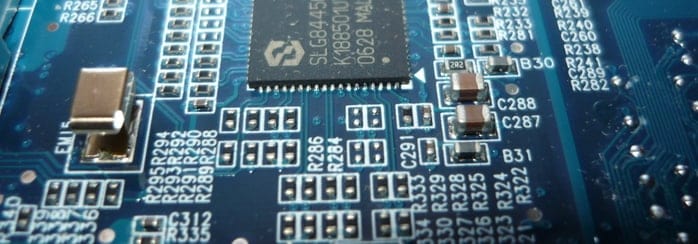Previously, we’ve already introduced the Kirchhoff’s Circuit Law as a separate topic. And today, we shall consider another method for the circuit analysis, which is called the Mesh Current Method. The advantage of this method is that we obtain less unknown variables and equations when we solve the circuit. Let’s consider the T-circuit scheme from the mentioned post and solve it with the help of the Mesh Current Method.
 Let the first voltage source (or the battery) be 10 V and the second one – 15 V. Let the resistances be R_1 = 15\ \Omega, R_2 = 22\ \Omega and R_3 = 30\ \Omega. Our task is to analyze the circuit and find the currents I_1, I_2, I_3 and the voltage drops on resistances R_1, R_2, R_3.
Let the first voltage source (or the battery) be 10 V and the second one – 15 V. Let the resistances be R_1 = 15\ \Omega, R_2 = 22\ \Omega and R_3 = 30\ \Omega. Our task is to analyze the circuit and find the currents I_1, I_2, I_3 and the voltage drops on resistances R_1, R_2, R_3.
First, we need to identify the loops in our circuit. As we can see in the scheme above, the first loop consists of the battery V_1, and two resistors (R_2 and R_3). The second one consists of the battery V_2, and two resistors (R_2 and R_3). Let’s choose the clockwise direction of the current in the both loops as shown in the scheme above. Then, we can apply the Kirchhoff’s Voltage Law for both loops (we choose the sign minus for V_2 because we travel from positive to negative in the voltage source, thus the potential difference is negative):
V_1 = I_1(R_1 + R_3) – I_2R_2 (1)
V_2 = I_1R_3 – I_2(R_2 + R_3) (2)
Finally, after the substitution of the numbers, we get the system of equations for the mesh (or loops) currents:
10 = 45I_1 – 30I_2 , (3)
15 = 30I_1 – 52I_2 . (4)
Then, we can convert this system of equations into the matrix form:
[V]=[R]\cdot [I] (5)
\begin{bmatrix} 10 \\ 15\end{bmatrix} = \begin{bmatrix} 45 & -30 \\ 30 & -52\end{bmatrix}\cdot\begin{bmatrix} I_1 \\ I_2\end{bmatrix}
From the Ohm’s law:
I=R^{-1}V
And we get:
[I]=[R^{-1}]\cdot [V]
here [R^{-1}] is the inverse matrix of [R].
Let’s now find [R^{-1}]. For the 2\times 2 matrix, there is the simple formula to find the inverse matrix:
\begin{bmatrix} a & b \\ c & d \end{bmatrix}^{-1} = \dfrac{1}{ad-bc}\cdot \begin{bmatrix} d & -b \\ -c & a \end{bmatrix}
here, a, b, c, d are the elements of the matrix, ad-bc is the determinant of the matrix.
Then, [R^{-1}] in our case will be
[R^{-1}] = \dfrac{1}{-45\cdot 52 + 30\cdot 30}\begin{bmatrix} -52 & 30 \\ -30 & 45 \end{bmatrix} = -\dfrac{1}{1440}\begin{bmatrix} -52 & 30 \\ -30 & 45 \end{bmatrix}
Finally, we can find the currents and
\begin{bmatrix} I_1 \\ I_2 \end{bmatrix} = -\dfrac{1}{1440}\begin{bmatrix} -52 & 30 \\ -30 & 45 \end{bmatrix}\cdot\begin{bmatrix} 10 \\ 15 \end{bmatrix}
I_1 = \dfrac{52\cdot 10 – 30\cdot 15}{1440} = 0.05 A
I_2 = \dfrac{30\cdot 10 – 45\cdot 15}{1440} = -0.26 A
Then, we can find the current I_3:
I_3 = I_1 – I_2 = 0.05 + 0.26 = 0.31 A
At last, the voltage drops on resistances R_1, R_2, R_3 will be:
I_1R_1 = 0.05\ A \cdot 15\ \Omega = 0.75\ V,
I_2R_2 = 0.26\ A \cdot 22\ \Omega = 5.72\ V,
I_3R_3 = 0.31\ A \cdot 30\ \Omega = 9.3\ V.
Therefore, we have convinced you that the Mesh Current Method reduces the number of equations and simplifies the calculations. And both are very useful for the complex circuit analysis.


